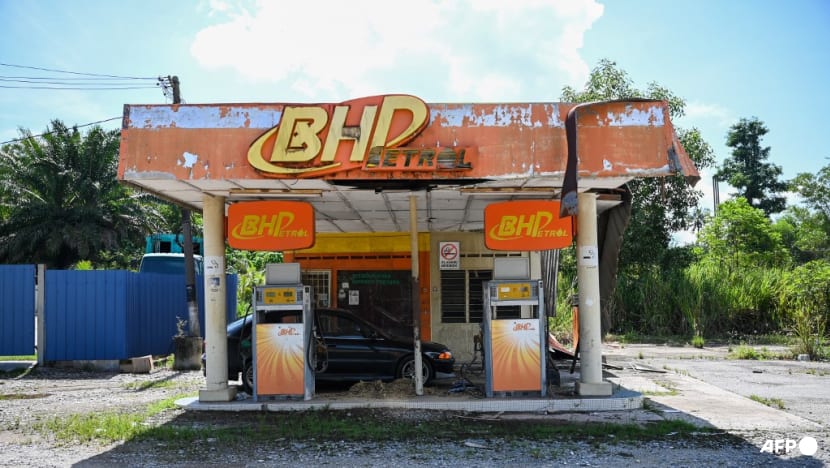Commentary: Malaysia’s difficult path to a low-carbon economy
Malaysia’s climate action commitments are vital, but difficult to achieve. A three-pronged approach opens possibilities to be a low-carbon economy, says ISEAS-Yusof Ishak Institute’s Dr Vinod Thomas.

File photo of an abandoned petrol station in Malaysia's Negeri Sembilan state on Jul 25, 2022. (Photo: AFP/Mohd Rasfan)
SINGAPORE: Malaysia faces the integral challenge of greening the economy as the country strives to sustain economic growth and improve people’s well-being.
To be sure, green growth is a global agenda and the burden rightly falls on the major economies and their disproportionately high carbon emissions.
Malaysia’s responsibility in mitigating emissions becomes clearer at the regional level; the country constitutes 5 per cent of Southeast Asia’s population but contributes 15 per cent of Southeast Asia’s carbon effluents, marking a relatively high figure per person.
Cleaner growth also enhances the investment climate: Notably, foreign interests are attracted to green investment, especially renewable energy in Southeast Asia, including Malaysia.
ESSENTIAL FOR GROWTH
Malaysia must accelerate economic transformation in line with its climate action goal of halving carbon emissions by 2030 (compared to 2005 levels). Climate action must not be viewed as inimical to growth but rather as essential for growth to be sustained.
Southeast Asia, by one study, could lose 30 per cent of gross domestic product by 2100 from labour productivity loss, workers’ health deterioration, spikes in natural disasters, and agricultural losses under a “high emission” scenario. Climate policies and investments, or decarbonisation, bring the social benefit of averting such economic calamity.
Decarbonising the economy also entails a social cost, even if the cost is estimated to be far smaller than the social benefit. Nevertheless, public policy must give due attention to adverse social impacts, such as the potential displacement of over 40,000 workers currently in Malaysia’s petroleum, chemical, rubber and plastic industries, when these industries are scaled down or even phased out.
Economic policies must also provide training and safety nets for workers caught in the transition, and emphasise job opportunities in new, scaled-up green industries such as renewable energy.
About 92 per cent of energy production in Malaysia is based on the fossil fuels of coal, oil, and gas. Energy production, comprising electricity and heat, is associated with nearly 50 per cent of carbon emissions.
Significantly, transport is next, with 29 per cent (compared to a global average of 25 per cent), followed by industry, which encompasses manufacturing and construction.
The phasing out of fossil fuels in electricity generation is the centrepiece of Malaysia’s 2050 net zero commitment. Recent five-year plans have embraced environmental sustainability, including the National Energy Transition Roadmap (2023-2050), National Energy Policy (2022-2040), Green Technology Master Plan (2017-2030), the Feed-in-Tariff mechanism introduced in 2015, and the Renewable Energy Act of 2011.
THREE-PRONGED APPROACH
A three-pronged approach across incentives, investments, and institutions would help Malaysia meet, or hopefully exceed, the goals envisaged in these plans.
First, regulatory policies in industry and in transport need to tilt incentives more strongly in favour of low-carbon energy. Through pricing strategies that favour clean energy, market signals can nudge the consumer to opt for renewable energy supply.
The implementation and scale-up of the Green Electricity Tariff launched in 2023 is a step in the right direction, in addition to the feed-in tariff that enables the purchase of renewable energy from the grid at a favourable rate. The full removal of fuel subsidies would also discourage fossil fuel consumption.
Malaysia ranks 20th among the 25 big providers of fuel subsidies. The country has continued to subsidise liquid petroleum gas, natural gas, and domestic electricity, but is expected to cut petrol subsidies this year to lower the fiscal deficit.
The renewable energy market can also be further deregulated to facilitate more choice and competition. For example, enabling direct third-party installation of domestic solar panels and direct sale of energy to consumers would make the renewable programmes more attractive. As recognised by the authorities, private contractors would be motivated to lease rooftops from households to install solar panels if they could supply to the grid and thus earn more revenue.
Second, Malaysia should pursue the huge potential for green investment in electric vehicles (EVs), including motorcycles, and in hydrogen-based industries. Malaysia could set up to be an innovation leader, for example, in the use of battery-swapping technology in EVs to cut recharge times and improve battery life. The incentives for EV adoption, such as the road tax exemption and personal tax exemption relating to EV expenses, are justified. An EV revolution would be key to Kuala Lumpur’s 2030 goal of reducing carbon intensity to 45 per cent of the 2005 level.
A breakthrough in hydrogen presents the biggest hope in renewable technology. Green hydrogen is a clean energy alternative that can generate immense heat while producing water as a byproduct. However, its commercialisation faces tough challenges, especially due to the high cost of producing hydrogen. The possibilities are already growing, with hydrogen being increasingly used in chemicals, textile fibre manufacturing, glass, electronics, and metallurgy.
Malaysia has great potential in this area as positive experiences emerge, for example in Sarawak, where projects such as H2ornbill and H2biscus, in collaboration with Japanese and South Korean partners respectively, have made strides in hydrogen-based, export-oriented industries.
Third, Malaysia needs to shore up institutional and financial support. Some key areas include education programmes and funding to equip the workforce for a low-carbon economy, and financing models, incentives and grants for green technology adoption and green technology R&D.
The country needs clearer standards and regulations in renewable markets, and more stringent monitoring of green investments, to enhance transparency and accountability. The government could also address the formulation of a green taxonomy, which local banks have indicated would be valuable in establishing criteria for approving green loans. Finally, enhancing the accessibility and quality of data will be crucial for policy analysis, monitoring, evaluation, and future reforms.
With its heavy reliance on fossil fuels, Malaysia faces a tough but essential road to decarbonisation. Nonetheless, the country is well-positioned to tap into emerging technological opportunities for low-carbon growth in industry and transport. Moving forward, Malaysia must boldly and swiftly spur green investments and pursue its carbon reduction goals.
Vinod Thomas is a Visiting Senior Fellow at the ISEAS - Yusof Ishak Institute. This commentary first appeared on the Institute's blog, Fulcrum.



















